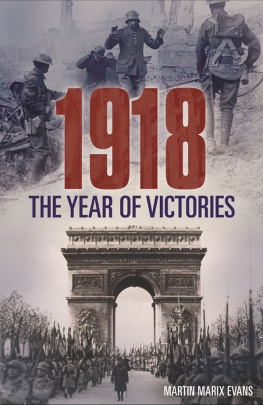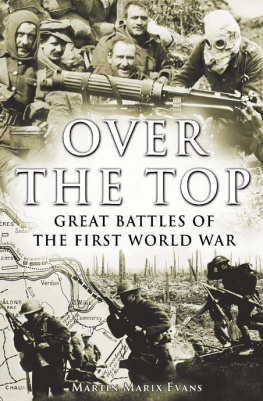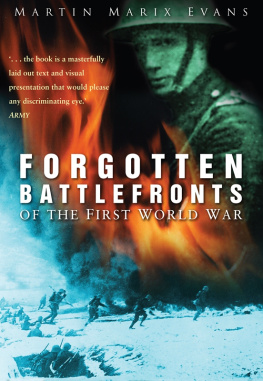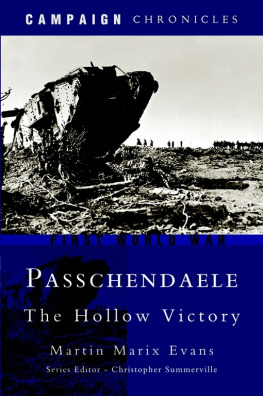Martin Marix Evans - 1918: The Year of Victories
Here you can read online Martin Marix Evans - 1918: The Year of Victories full text of the book (entire story) in english for free. Download pdf and epub, get meaning, cover and reviews about this ebook. publisher: Arcturus, genre: History. Description of the work, (preface) as well as reviews are available. Best literature library LitArk.com created for fans of good reading and offers a wide selection of genres:
Romance novel
Science fiction
Adventure
Detective
Science
History
Home and family
Prose
Art
Politics
Computer
Non-fiction
Religion
Business
Children
Humor
Choose a favorite category and find really read worthwhile books. Enjoy immersion in the world of imagination, feel the emotions of the characters or learn something new for yourself, make an fascinating discovery.
- Book:1918: The Year of Victories
- Author:
- Publisher:Arcturus
- Genre:
- Rating:3 / 5
- Favourites:Add to favourites
- Your mark:
- 60
- 1
- 2
- 3
- 4
- 5
1918: The Year of Victories: summary, description and annotation
We offer to read an annotation, description, summary or preface (depends on what the author of the book "1918: The Year of Victories" wrote himself). If you haven't found the necessary information about the book — write in the comments, we will try to find it.
1918: The Year of Victories — read online for free the complete book (whole text) full work
Below is the text of the book, divided by pages. System saving the place of the last page read, allows you to conveniently read the book "1918: The Year of Victories" online for free, without having to search again every time where you left off. Put a bookmark, and you can go to the page where you finished reading at any time.
Font size:
Interval:
Bookmark:

For the human aspect of war Malcolm Browns Imperial War Museum Book of 1918 is rewarding, and the strategic aspect is well covered by John Terraines To Win a War. The most coherent overall history is, in my view, David Trasks The AEF and Coalition Warmaking which, while obviously addressing itself to the American involvement, offers a clarity of narrative rarely found. The final days of the war are fascinatingly described in Stanley Weintraubs A Stillness Heard Around the World and both German and French views of events and plans can be obtained from Martin Kitchens The German Offensives of 1918.
In addition to the sources listed below, material has been quoted from unpublished papers held in the World War I Survey archives at the United States Army Military History Institute, Carlisle, PA for access to which the author is deeply grateful. Certain first-hand accounts have been requoted from the works of Malcolm Brown, Paul Greenwood, Lyn Macdonald, Sir John Monash, Laurence Stallings and John Terraine. The unpublished memoirs of Dr Maurice Burton have been made available by Robert Burton whose kindness is acknowledged with equal gratitude. Mr Jan Deneys Reitz has been generous in permitting quotation from his fathers work.
American Battle Monuments Commission, American Armies and Battlefields in Europe, Washington, DC, US Government Printing Office, 1938; Center of Military History 1992.
Banks, Arthur, A Military Atlas of the First World War, London, Heinemann Educational Books, 1975; Leo Cooper, 1989.
Brown, Malcolm, The Imperial War Museum Book of 1918, the Year of Victory, London, Sidgwick & Jackson, 1998; Pan Books, 1999.
Coombs, Rose E. B., Before Endeavours Fade, London, Battle of Britain Prints International, 1994.
Goddard, Calvin H., Relations between AEF Forces and British Expeditionary Forces 19171920, unpublished paper, 1942, US Army Military History Institute, Carlisle, PA.
Goddard, Calvin H., Franco-American Relations, unpublished paper, 1942, US Army Military History Institute, Carlisle, PA.
Gray, Randal, with Argyll, Christopher, Chronicle of the First World War, 2 vols, Facts on File, New York, Oxford and Sydney, 1990.
Gray, Randal, Kaiserschlacht 1918, London, Osprey, 1991.
Greenwood, Paul, The Second Battle of the Marne, Shrewsbury, Airlife, 1998.
Griffith, Paddy, Battle Tactics of the Western Front: The British Armys Art of Attack 191618, New Haven & London, Yale University Press, 1994.
Griffiths, William R., The Great War, West Point Military History Series, Wayne, NJ, Avery, 1986.
Hammerton, J. A., A Popular History of the Great War, Volume 5: The Year of Victory, London, The Fleetway House, 1934.
Henry, Mark, A Place Just Built for Calamities, Osprey Military Journal, Vol. 1, Issue 1.
Johnson, Douglas V., II, and Rolfe L. Hillman, Jr, Soissons 1918, College Station, Texas A&M University Press, 1999.
Keegan, John, The First World War, London, Hutchinson, 1998.
Kitchen, Martin, The German Offensives of 1918, Stroud, Tempus, 2001.
Linnenkohl, Hans, Vom Einzelschuss zur Feuerwalze, Bonn, Bernard & Graefe, 1996.
Livesey, Anthony, The Viking Atlas of World War I, London and New York, Viking, 1994.
Macdonald, Lyn, To the Last Man, Spring 1918, London, Viking, 1998.
Marix Evans, Martin (ed.), American Voices of World War I Primary Source Documents, London and Chicago, Fitzroy Dearborn, 2001.
Marix Evans, Martin, The Battles of the Somme, London, Weidenfeld & Nicolson, 1996.
Marix Evans, Martin, Oudenaarde Revisited, Battlefields Review, Issue 17, Barnsley, 2002.
Marix Evans, Martin, Passchendaele and the Battles of Ypres, London, Osprey, 1997.
Marix Evans, Martin, Retreat Hell! We Just Got Here! The AEF in France, 19171918, Oxford, Osprey, 1998.
Middlebrook, Martin, The Kaisers Battle, London, Allen Lane, 1978 and Penguin 1983.
Monash, John, The Australian Victories in France in 1918, London, Angus & Robertson, 1936 and London and Nashville, Imperial War Museum and Battery Press, 1993.
Nicholson, G. W. L., Canadian Expeditionary Force 19141918, Ottawa, Queens Printer, 1962.
Pershing, John J., My Experiences in the World War, New York, Frederick A. Stokes, and London, Hodder & Stoughton, 1931.
Reitz, Deneys, Trekking On, London, Faber, 1933; Prescott, Arizona, Wolfe Publishing, 1994.
Reports from Mounted Infantry in South Africa, 18991900: Machine Guns, 57 Cape 8122, National Army Museum, London, 7805-26.
Schmidt, Capt., The Battle in the Intermediate Zone, Supplement to Summary of Information No. 140, GHQAEF, 1918.
Sheffield, Gary, Forgotten Victory. The First World War: Myths and Realities, London, Headline, 2001.
Spaulding, Oliver L., and Wright, John W., The Second Division American Expeditionary Force in France 19171919, New York, Hillman Press, 1937.
Stallings, Laurence, The Doughboys: The Story of the AEF 19171918, New York, Harper & Row, 1963.
Terraine, John, The Smoke and the Fire, Myths and Anti-Myths of War 18611945, London, Sidgwick & Jackson, 1980.
Terraine, John, To Win a War. 1918, The Year of Victory, London, Sidgwick & Jackson, 1978.
Trask, David F., The AEF and Coalition Warmaking 19171918, University Press of Kansas, Lawrence KS, 1993.
Weintraub, Stanley, A Stillness Heard Around the World. The End of the Great War, November 1918, New York, E. P. Dutton and London, Allen & Unwin, 1985.
Zabecki, David T., Colonel Georg Bruchmller and the Birth of Modern Artillery Tactics in Stand To!, No.53, September 1998.
BY NOVEMBER 1917, it was clear that Germanys chances of winning the war were becoming slimmer as time passed. If they could not defeat the Allies, or persuade one of them to make a separate peace in 1918, they would face certain defeat in 1919. The Allied blockade was preventing Germanys sea-borne imports from being shipped in, while the Allied convoy system denied the German U-boat blockade similar success. The Americans had entered the war in April 1917, with the consequence of putting victory in the war of industrial production beyond German reach. What was more, the build-up of American forces in Europe was now becoming significant and by the end of 1918 could be foreseen as being overwhelming. Of their adversaries the Germans thought that the French were highly professional and strongly motivated while the British were stubborn and tough, but lacking in operational sophistication and flexibility. Given that the French army had mutinied that year, unknown to the Germans, and being unable to foresee the events of the coming July and August, the inaccuracy of these assessments is understandable but was to prove a fatal error.
The German experience on the Western Front had been mainly of success in defence. Only two major offensive campaigns had been attempted so far: the initial invasion of France and Belgium in 1914 and the assault on Verdun. The first outran both their command and control capability and their supply lines, a lesson that went unheeded. The second was planned as a device to tempt France into suicidal counter-attacks, but a failure by the Germans to adhere to their strategy, allowing themselves to be drawn into the attack, counter-attack, counter-to-the-counter-attack sequence that is war of attrition, led to their failure. On the Eastern Front, however, they had enjoyed success in aggression and particularly in the weeks immediately prior to their late 1917 cogitations. On 3 September they had taken the Baltic port of Riga after a stunning artillery bombardment.
Font size:
Interval:
Bookmark:
Similar books «1918: The Year of Victories»
Look at similar books to 1918: The Year of Victories. We have selected literature similar in name and meaning in the hope of providing readers with more options to find new, interesting, not yet read works.
Discussion, reviews of the book 1918: The Year of Victories and just readers' own opinions. Leave your comments, write what you think about the work, its meaning or the main characters. Specify what exactly you liked and what you didn't like, and why you think so.









